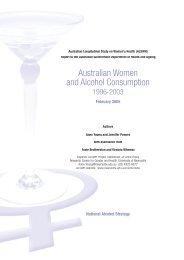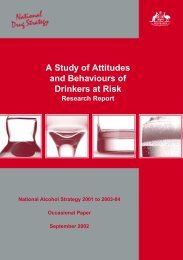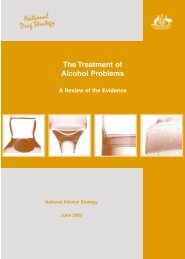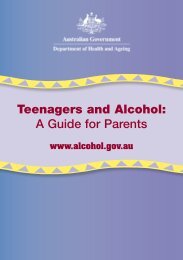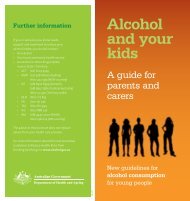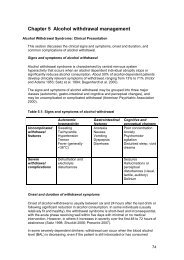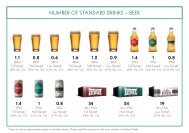Chapter 3 Screening, assessment and treatment planning - Alcohol
Chapter 3 Screening, assessment and treatment planning - Alcohol
Chapter 3 Screening, assessment and treatment planning - Alcohol
Create successful ePaper yourself
Turn your PDF publications into a flip-book with our unique Google optimized e-Paper software.
Miller, W 1995, Increasing motivation for change. In: Hester, RK <strong>and</strong> W Miller (eds)H<strong>and</strong>book of <strong>Alcohol</strong>ism Treament Approaches. Boston: Allyn & Bacon.Miller, WR <strong>and</strong> AC Page 1991, Warm turkey: other routes to abstinence. J SubstAbuse Treat 8(4):227-32.Miller, WR, RG Sovereign <strong>and</strong> B Krege 1988, Motivational interviewing with problemdrinkers: 2. The Drinkers Checkup as a preventive intervention. BehavPsychother 16(4): 251-268.Miller, W <strong>and</strong> S Rollnick 2002, Motivational interviewing: preparing people forchange. New York: Guilford Press.Moraes, CL, EF Viellas <strong>and</strong> ME Reichenheim 2005, Assessing alcohol misuse duringpregnancy: evaluating psychometric properties of the CAGE, T-ACE <strong>and</strong>TWEAK in a Brazilian setting. J Stud <strong>Alcohol</strong> 66(2): 165-173.Musshoff, F <strong>and</strong> T Daldrup 1998, Determination of biological markers for alcoholabuse. J Chromatogr B Biomed Sci Appl 713(1):245-264.NHMRC 2001, Australian <strong>Alcohol</strong> Guidelines: Health Risks <strong>and</strong> Benefits. Canberra:National Health & Medical Research Council.NHMRC 2009, Australian Guidelines To Reduce Health Risks from Drunking <strong>Alcohol</strong>.Canberra: National Health & Medical Research Council.Orford, J, Hodgson R, Copello A et al. 2006, The clients’ perspective on changeduring <strong>treatment</strong> for an alcohol problem: qualitative analysis of follow-upinterviews in the UK <strong>Alcohol</strong> Treatment Trial. Addiction 101, 60-68.Piccinelli, M, Tessari E, Bortolomasi M et al. 1997a, Efficacy of the alcohol usedisorders identification test as a screening tool for hazardous alcohol intake<strong>and</strong> related disorders in primary care: a validity study. BMJ 314(7078): 420-424.Piccinelli, M, Tessari E, Bortolomasi M et al. 1997b, Efficacy of the alcohol usedisorders identification test as a screening tool for hazardous alcohol intake<strong>and</strong> related disorders in primary care: a validity study. BMJ 314(7078): 420-424.Pinto, E <strong>and</strong> R Peters 2009, Literature review of the Clock Drawing Test as a tool forcognitive screening. Dement Geriatr Cogn Disord. 27(3):201-13.Prochaska, JO, CC DiClemente <strong>and</strong> JC Norcross 1992, In search of how peoplechange. Applications to addictive behaviors. Am Psychol 47(9): 1102-1114.Project MATCH Research Group 1997, Matching alcoholism <strong>treatment</strong>s to clientheterogeneity: Project MATCH post<strong>treatment</strong> drinking outcomes. J Stud<strong>Alcohol</strong> 58(1): 7-29.Project MATCH Research Group 1998, Matching alcoholism <strong>treatment</strong>s to clientheterogeneity: Project MATCH three-year drinking outcomes. <strong>Alcohol</strong> ClinExp Res 22(6): 1300.46



